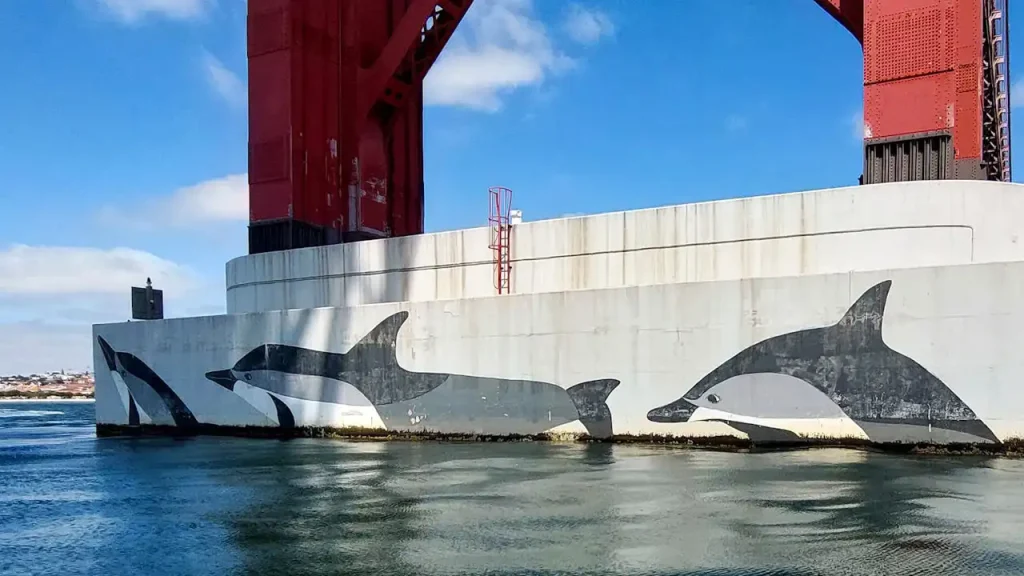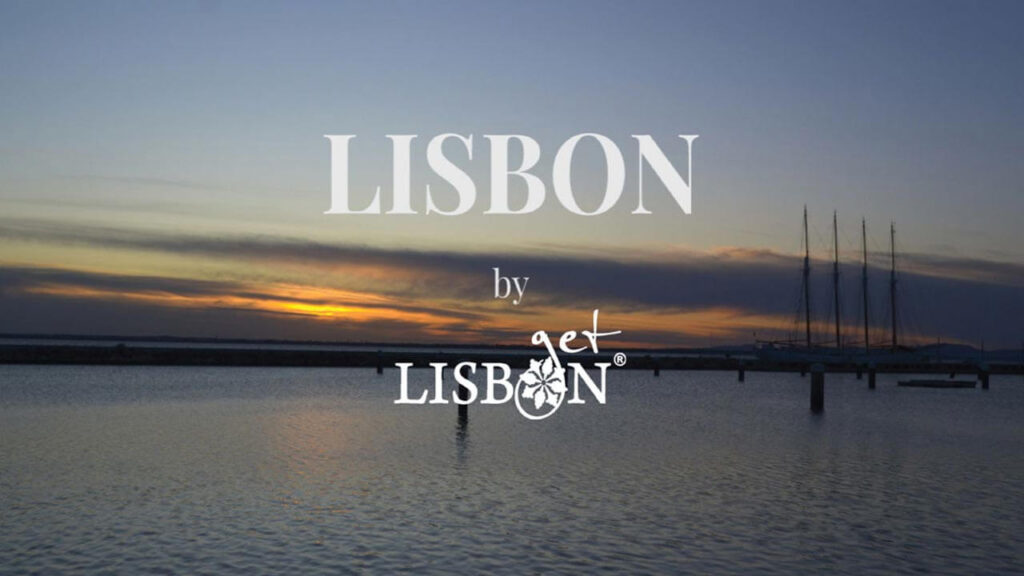The return of dolphins to the Tagus Estuary has captivated both Lisbon locals and visitors. This exciting phenomenon inspired us to seek them out across the city. We discovered ways to observe them in real life as well as various representations of dolphins in Lisbon. While direct observation is a unique experience and the artistic references we found were surprising, what truly moved us were the messages they conveyed.
Dolphins and the Tagus Estuary
The recent sightings of this charismatic species in the Tagus Estuary have generated enthusiasm and raised awareness about the need to question, study, and reflect on various aspects related to their presence.
Historical references dating back more than two centuries indicate that dolphins were once common in this estuary, thanks to a rich ecosystem providing ample food for these mammals.
However, from the 1960s onwards, their gradual disappearance was observed, directly linked to river pollution and overfishing.
Their resurgence began around the turn of the century, coinciding with the implementation of various measures, such as wastewater treatment and the reduction of polluting industries. These efforts partially reversed environmental degradation, restoring fish populations and improving their habitats.
A report by the Associação Natureza Portugal/World Wide Fund for Nature (WWF), published in October 2022, highlighted the need for further studies to better understand the relationship between dolphins and the Tagus Estuary. However, the report pointed to the availability of food as one of the main factors contributing to their return.
It is crucial to maintain collective efforts to keep this fragile ecosystem healthy, ensuring favourable conditions for the cetaceans that visit us.
As the report suggests, these charming mammals can play a fundamental role as a symbol of mobilisation and an indicator of the river’s health:
- “Dolphins can act as flagship species in the Tagus Estuary, encouraging the involvement of various partners in initiatives aimed at improving environmental conditions in the region.”
- “Dolphins can also serve as sentinel species for the estuary’s health, as their presence, absence, and behaviour reflect its environmental quality.”
From this perspective, we believe that other forms of dolphin representation in Lisbon can also contribute to the promotion of marine conservation.
Dolphins in Lisbon
To find dolphins in Lisbon, we explored the river and wandered through the city, identifying seven different manifestations, all carrying a common message.
Dolphin-Watching Boat Tours

Several maritime tourism operators in Lisbon offer boat trips dedicated to dolphin watching.
The two species most commonly sighted are the common dolphin and the bottlenose dolphin. They can be seen swimming at high speeds, leaping out of the water, or accompanied by their graceful calves. When they approach the boats, the experience becomes truly breathtaking.
Additionally, the harbour porpoise, another cetacean species, can also occasionally be spotted. The presence of various seabirds adds to this unforgettable experience.
Today, the estuary is also a birthing site, with rare and extraordinary moments of dolphin births even being filmed.
A specialist briefing before and after the tour, along with expert guidance throughout the trip, provides participants with insights into the species and best practices for minimising disturbance during encounters. These operators also contribute to dolphin population monitoring and respond to stranding incidents.
These tours offer a thrilling experience, and with a bit of luck, depending on the season, sightings of fin whales make them even more extraordinary.
By purchasing your tickets here you are supporting the getLISBON project.
Dolphin Bay at Lisbon Zoo
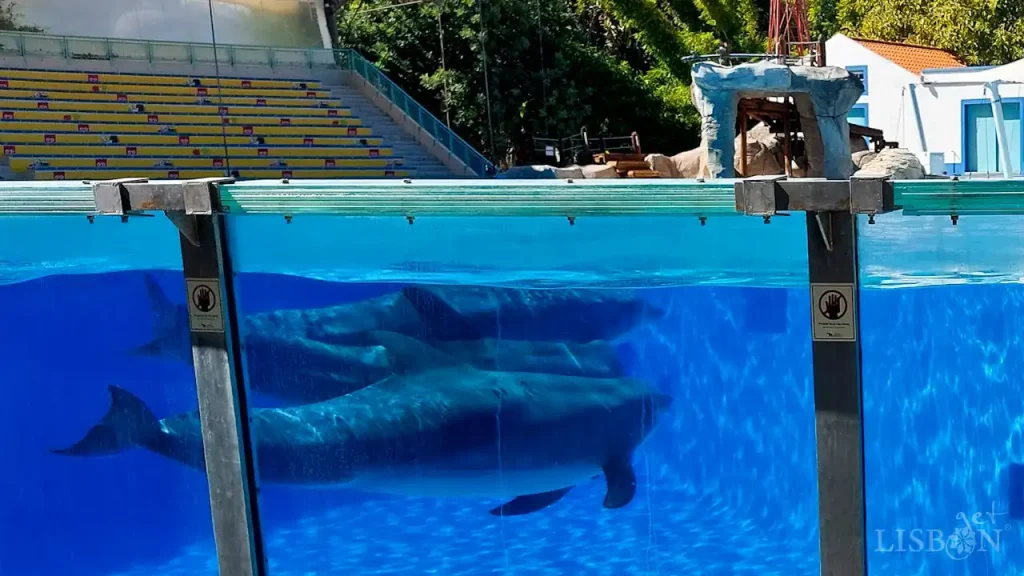
One of the main attractions at the Lisbon Zoo is the dolphin acrobatics show, where these intelligent mammals collaborate with trainers to delight children and adults alike.
These performances promote awareness of marine biodiversity conservation and the value of the oceans, while also highlighting the growing threat of marine pollution.
However, such exhibitions are increasingly questioned, as these highly sensitive animals are kept in captivity, confined to tanks that are far from replicating their natural habitats and too small for their size.
There is growing awareness of this issue, but dolphins in captivity are not prepared to be released into the wild. A long-term solution involves creating sanctuaries where they can live in a protected natural environment.
Dolphins on the Pillars of the 25 de Abril Bridge
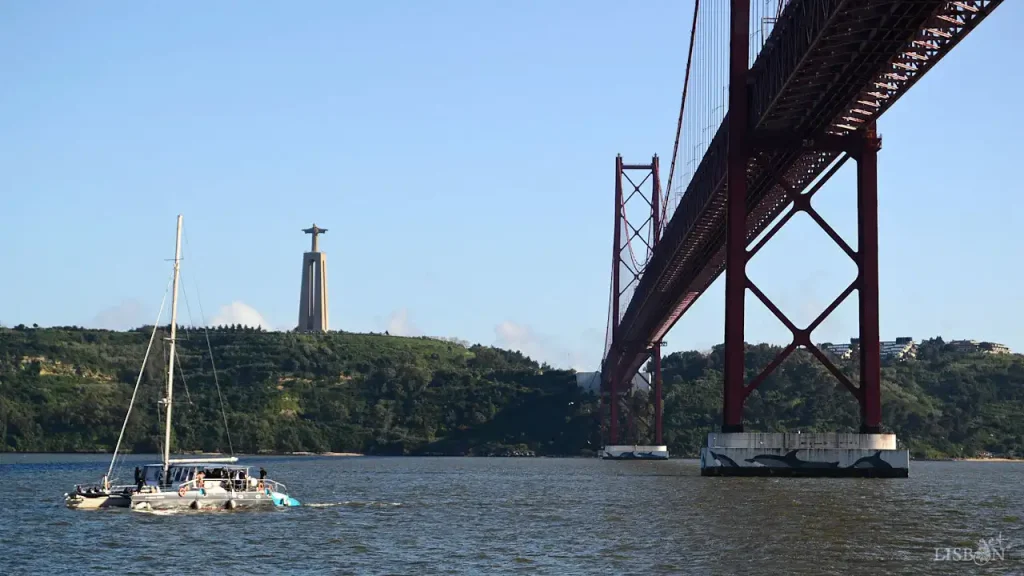
Dolphins, orcas, sperm whales, and seabirds were painted on the foundation pillars of the 25 de Abril Bridge during conservation works in 2012.
This initiative, launched by the then Estradas de Portugal, was inspired by the return of dolphins to the Tagus and aimed to raise environmental awareness.
The represented mammals inhabit Portuguese waters, while the birds, such as flamingos, avocets, and curlews, are residents of the Tagus Estuary.
Dolphin on a Sanitation Cover
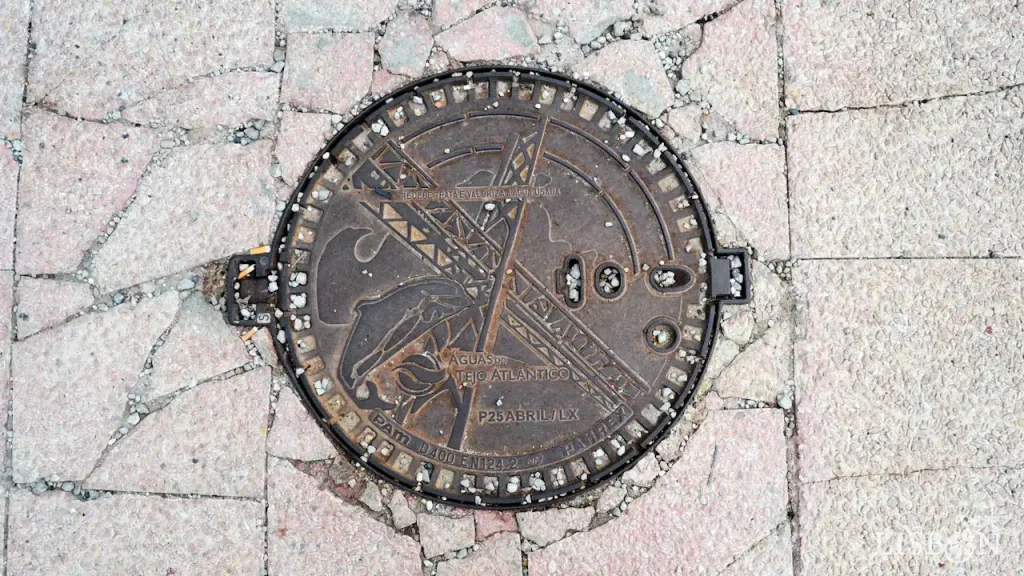
At Doca de Santo Amaro, there is a manhole cover featuring the 25 de Abril Bridge and a dolphin. This intervention is part of a collection of 12 designs by the visual artist Gilberto Gaspar, which depict emblematic locations and monuments of Lisbon, engraved on permanent access covers. The collection includes Parque das Nações, Belém Tower, Terreiro do Paço, Jerónimos Monastery, Padrão dos Descobrimentos, Sé Cathedral, São Jorge Castle, Rossio, Restauradores, Marquês de Pombal, and Campo Pequeno.
This project, titled “There Is Art in the Sewer,” was launched on 19 November 2021, World Toilet Day, by Águas do Tejo Atlântico, the entity responsible for wastewater treatment in Greater Lisbon and the West.
It aims to draw public attention to overlooked urban surfaces and highlight the importance of wastewater treatment for public health and the environment.
Read our article “Design in Manhole Covers of Lisbon” which also explores permanent access covers—an often-overlooked detail in the urban landscape.
‘Rio Tejo’ Mural
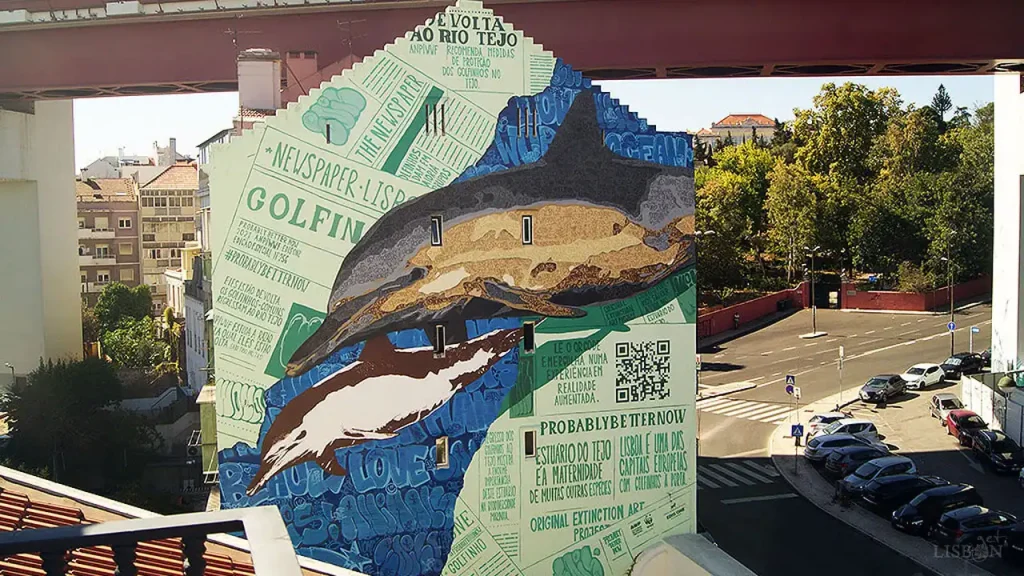
A large mural featuring two common dolphins can be found in the garden of the Alcântara Library. Created in 2021, it includes newspaper clippings reporting on the return of these cetaceans to the Tagus, delivering a clear message: raising awareness among the public and authorities about the need to protect them.
This work is by EDIS One, a street artist and WWF Portugal ambassador, who is dedicated to projects highlighting the importance of preserving endangered species.
| Never miss another article | Subscribe here |
‘O Golfinho do Tejo’
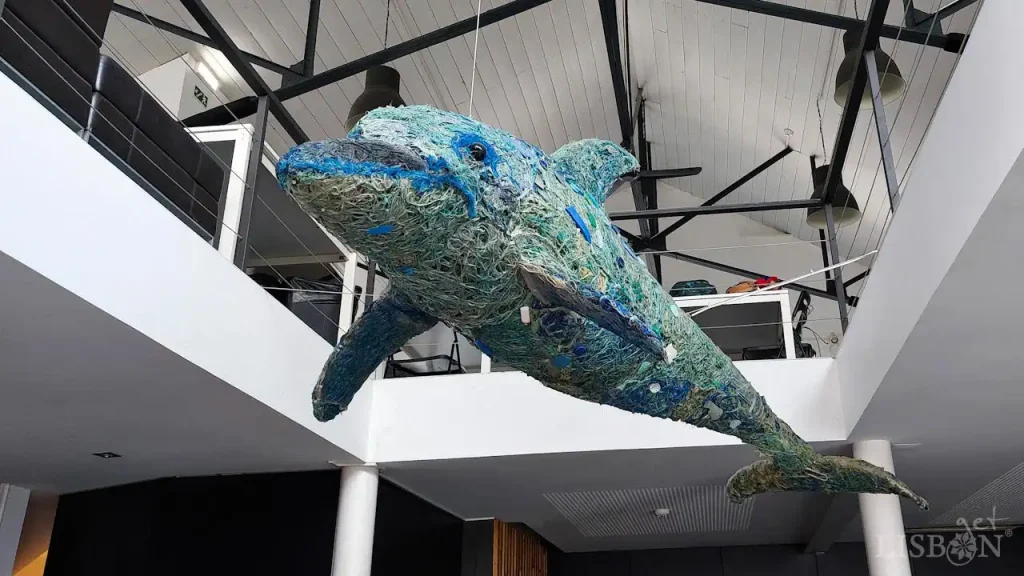
Created in 2022 by the artistic collective Skeleton Sea, ‘O Golfinho do Tejo’ is a sculpture made from beach litter and fishing nets. Led by artist Xandi, this project seeks to raise awareness of the global marine pollution crisis through artworks crafted from ocean debris.
This sculpture is on display at the Mercedes-Benz Oceanic Lounge at Santo Amaro Dock, where dolphin-watching tours depart. The tours, in partnership with organisations such as the Lisbon Aquarium, promote marine conservation through various initiatives.


Dolphin in Portuguese Pavement
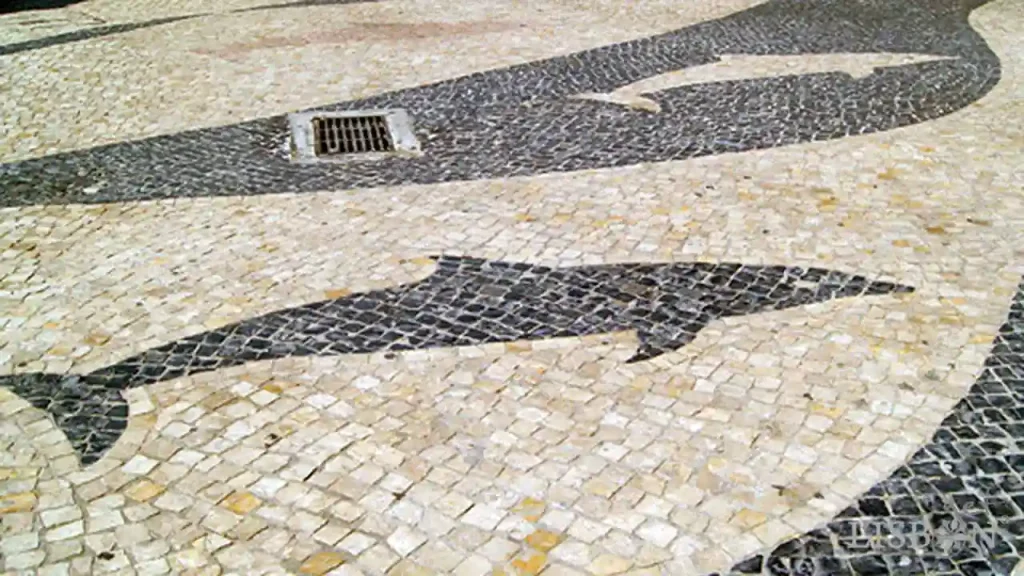
While researching for our article ‘Animals and Fantastic Creatures in the Portuguese Pavement of Lisbon‘ we did not find any dolphin representations in Lisbon. However, we identified these graceful mammals in Cacilhas, a riverside town that shares Lisbon’s close connection with the Tagus and the responsibility for preserving the estuary and protecting cetaceans.
We hope this article has helped bring attention to this issue. We believe that more artistic representations of dolphins in Lisbon will certainly inspire the public and stakeholders to take action in preserving and improving the marine conditions of Portugal’s largest wetland and one of the most important in Europe: the Tagus Estuary.
The project getLISBON has been very rewarding and we want to continue revealing the singularities of fascinating Lisbon.
Help us keep this project alive!
By using these links to make your reservations you’ll be supporting us. With no extra costs!
• Looking for a different experience? We can create a customised itinerary based on your interests. Contact us!
• Or if you prefer tours and other activities in various destinations, take a look at GetYourGuide.
• Save time and money with a flexible Lisbon Card!

